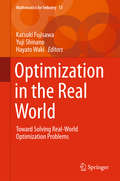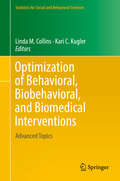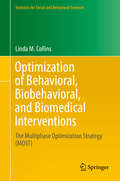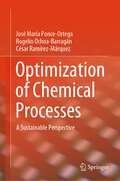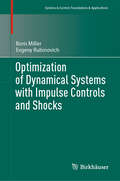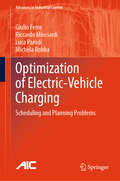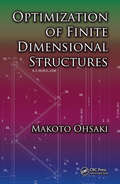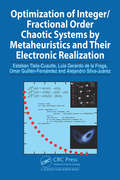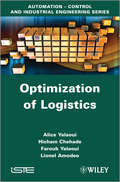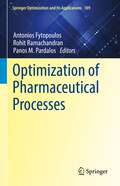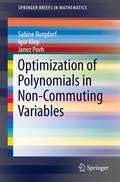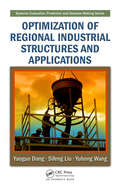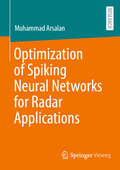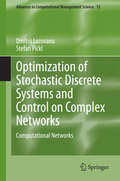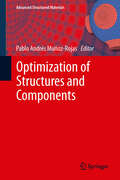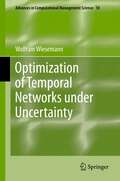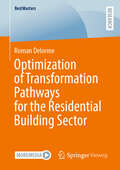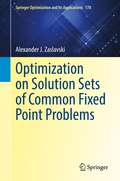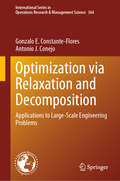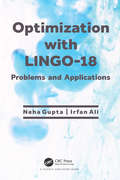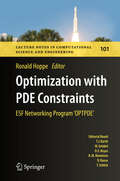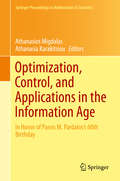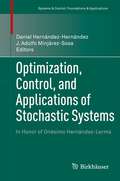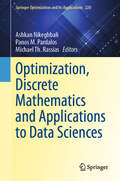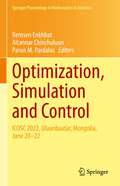- Table View
- List View
Optimization in the Real World
by Katsuki Fujisawa Yuji Shinano Hayato WakiThis book clearly shows the importance, usefulness, and powerfulness of current optimization technologies, in particular, mixed-integer programming and its remarkable applications. It is intended to be the definitive study of state-of-the-art optimization technologies for students, academic researchers, and non-professionals in industry. The chapters of this book are based on a collection of selected and extended papers from the "IMI Workshop on Optimization in the Real World" held in October 2014 in Japan.
Optimization of Behavioral, Biobehavioral, and Biomedical Interventions: Advanced Topics (Statistics for Social and Behavioral Sciences)
by Linda M. Collins Kari C. KuglerBehavioral, biobehavioral, and biomedical interventions are programs with the objective of improving and maintaining human health and well-being, broadly defined, in individuals, families, schools, organizations, or communities. These interventions may be aimed at, for example, preventing or treating disease, promoting physical and mental health, preventing violence, or improving academic achievement. This book provides additional information on a principled empirical framework for developing interventions that are more effective, efficient, economical, and scalable. This framework is introduced in the monograph, "Optimization of Behavioral, Biobehavioral, and Biomedical Interventions: The Multiphase Optimization Strategy (MOST)" by Linda M. Collins (Springer, 2018). The present book is focused on advanced topics related to MOST. The chapters, all written by experts, are devoted to topics ranging from experimental design and data analysis to development of a conceptual model and implementation of a complex experiment in the field. Intervention scientists who are preparing to apply MOST will find this book an important reference and guide for their research. Fields to which this work pertains include public health (medicine, nursing, health economics, implementation sciences), behavioral sciences (psychology, criminal justice), statistics, and education.
Optimization of Behavioral, Biobehavioral, and Biomedical Interventions: The Multiphase Optimization Strategy (MOST) (Statistics for Social and Behavioral Sciences)
by Linda M. CollinsThis book presents a framework for development, optimization, and evaluation of behavioral, biobehavioral, and biomedical interventions. Behavioral, biobehavioral, and biomedical interventions are programs with the objective of improving and maintaining human health and well-being, broadly defined, in individuals, families, schools, organizations, or communities. These interventions may be aimed at, for example, preventing or treating disease, promoting physical and mental health, preventing violence, or improving academic achievement. This volume introduces the multiphase optimization strategy (MOST), pioneered at The Methodology Center at the Pennsylvania State University, as an alternative to the classical approach of relying solely on the randomized controlled trial (RCT). MOST borrows heavily from perspectives taken and approaches used in engineering, and also integrates concepts from statistics and behavioral science, including the RCT. As described in detail in this book, MOST consists of three phases: preparation, in which the conceptual model underlying the intervention is articulated; optimization, in which experimentation is used to gather the information necessary to identify the optimized intervention; and evaluation, in which the optimized intervention is evaluated in a standard RCT. Through numerous examples, the book demonstrates that MOST can be used to develop interventions that are more effective, efficient, economical, and scalable.Optimization of Behavioral, Biobehavioral, and Biomedical Interventions: The Multiphase Optimization Strategy is the first book to present a comprehensive introduction to MOST. It will be an essential resource for behavioral, biobehavioral, and biomedical scientists; statisticians, biostatisticians, and analysts working in epidemiology and public health; and graduate-level courses in development and evaluation of interventions.
Optimization of Chemical Processes: A Sustainable Perspective
by José María Ponce-Ortega Rogelio Ochoa-Barragán César Ramírez-MárquezThis textbook introduces readers to a comprehensive framework for the application of deterministic optimization strategies in the field of chemical processes, with a strong emphasis on sustainability.The book establishes a vital connection between fundamental deterministic optimization principles, optimization tools, and real-world application instances, all within the context of environmentally responsible practices. The approach put forth in this book is exceptionally versatile, allowing for the use of many optimization software and deterministic techniques.Contained in the book are many fundamental optimization concepts, encompassing linear programming, nonlinear programming, integer programming, and multi-objective optimization, all tailored to promote sustainable decision-making. Furthermore, the book provides practical examples illustrating the application of these techniques within sustainable chemical processes as tutorials.The textbook also explores the utilization of popular optimization software platforms such as GAMS, MATLAB, and Python, demonstrating how these tools can be leveraged for eco-friendly process optimization. Through this comprehensive framework, readers can not only acquire the skills needed to optimize a wide range of processes but also learn how to do so with sustainability at the forefront of their considerations. This approach streamlines the optimization process, eliminating unnecessary complications along the way and ensuring that environmental and ethical considerations are integral to the decision-making process.
Optimization of Dynamical Systems with Impulse Controls and Shocks (Systems & Control: Foundations & Applications)
by Boris Miller Evgeny RubinovichThis text explores the state-of-the-art in the rapidly developing theory of impulse control and introduces the theory of singular space-time transformations, a new method for studying shock mechanical systems. Two approaches in the theory of impulse control are presented: The first, more traditional approach defines the impulsive action as a discontinuity of phase coordinates depending on the current time, the state preceding the action, and its magnitude. The second requires the use of modern methods for describing dynamical systems - differential equations with measures. The impulse is treated as an idealization of a very short action of high magnitude, which produces an almost abrupt change of phase coordinates. The relation between these two approaches is also discussed, and several applications, both traditional and emerging, are considered. This text is intended for graduate students and researchers in control engineering and optimal control theory for dynamical systems. Readers are assumed to be familiar with the theory of ODEs, optimal control, and functional analysis, though an appendix is included that covers many of the necessary mathematical concepts.
Optimization of Electric-Vehicle Charging: Scheduling and Planning Problems (Advances in Industrial Control)
by Giulio Ferro Riccardo Minciardi Luca Parodi Michela RobbaThis book provides models and methods for the optimal management of electrical vehicles through an interdisciplinary approach that brings together knowledge from the sectors of transportation, manufacturing and smart grids. Optimization of Electric-Vehicle Charging explores several optimization models for the scheduling of electric vehicles in a smart grid. Both discrete-time and discrete-event approaches are considered to minimize tardiness, charging and production costs, on the basis of information like release time, due date, deadline, energy request, and availability of energy generated from renewable sources. Transportation demand is assessed, as well as user-equilibrium-based approaches, for the location of charging stations and for the assignment of users to multiple charging stations. Employing illustrations, tables and examples to elucidate the ideas presented, this book will be of value to researchers and practitioners in the fields of electrical engineering and transportation, as well as to graduate and PhD students.
Optimization of Finite Dimensional Structures
by Makoto OhsakiOriginally developed for mechanical and aeronautical engineering, structural optimization is not so easily applied to civil and architectural engineering, as structures in these fields are not mass products, but more often unique structures planned in accordance with specific design requirements. The shape and geometry of such structures are determ
Optimization of Integer/Fractional Order Chaotic Systems by Metaheuristics and their Electronic Realization
by Esteban Tlelo-Cuautle Alejandro Silva-Juárez Luis Gerardo de la Fraga Omar Guillén Guillén-FernándezMathematicians have devised different chaotic systems that are modeled by integer or fractional-order differential equations, and whose mathematical models can generate chaos or hyperchaos. The numerical methods to simulate those integer and fractional-order chaotic systems are quite different and their exactness is responsible in the evaluation of characteristics like Lyapunov exponents, Kaplan-Yorke dimension, and entropy. One challenge is estimating the step-size to run a numerical method. It can be done analyzing the eigenvalues of self-excited attractors, while for hidden attractors it is difficult to evaluate the equilibrium points that are required to formulate the Jacobian matrices. Time simulation of fractional-order chaotic oscillators also requires estimating a memory length to achieve exact results, and it is associated to memories in hardware design. In this manner, simulating chaotic/hyperchaotic oscillators of integer/fractional-order and with self-excited/hidden attractors is quite important to evaluate their Lyapunov exponents, Kaplan-Yorke dimension and entropy. Further, to improve the dynamics of the oscillators, their main characteristics can be optimized applying metaheuristics, which basically consists of varying the values of the coefficients of a mathematical model. The optimized models can then be implemented using commercially available amplifiers, field-programmable analog arrays (FPAA), field-programmable gate arrays (FPGA), microcontrollers, graphic processing units, and even using nanometer technology of integrated circuits. The book describes the application of different numerical methods to simulate integer/fractional-order chaotic systems. These methods are used within optimization loops to maximize positive Lyapunov exponents, Kaplan-Yorke dimension, and entropy. Single and multi-objective optimization approaches applying metaheuristics are described, as well as their tuning techniques to generate feasible solutions that are suitable for electronic implementation. The book details several applications of chaotic oscillators such as in random bit/number generators, cryptography, secure communications, robotics, and Internet of Things.
Optimization of Logistics
by Lionel Amodeo Farouk Yalaoui Alice Yalaoui Hicham ChehadeThis book aims to help engineers, Masters students and young researchers to understand and gain a general knowledge of logistic systems optimization problems and techniques, such as system design, layout, stock management, quality management, lot-sizing or scheduling. It summarizes the evaluation and optimization methods used to solve the most frequent problems. In particular, the authors also emphasize some recent and interesting scientific developments, as well as presenting some industrial applications and some solved instances from real-life cases.Performance evaluation tools (Petri nets, the Markov process, discrete event simulation, etc.) and optimization techniques (branch-and-bound, dynamic programming, genetic algorithms, ant colony optimization, etc.) are presented first. Then, new optimization methods are presented to solve systems design problems, layout problems and buffer-sizing optimization. Forecasting methods, inventory optimization, packing problems, lot-sizing quality management and scheduling are presented with examples in the final chapters.
Optimization of Pharmaceutical Processes (Springer Optimization and Its Applications #189)
by Panos M. Pardalos Rohit Ramachandran Antonios FytopoulosOptimization of Pharmaceutical Processes presents contributions from leading authorities in the fields of optimization and pharmaceutical manufacturing. Formulated within structured frameworks, practical examples and applications are given as guidance to apply optimization techniques to most aspects of pharmaceutical processes from design, to lab and pilot scale, and finally to manufacturing. The increasing demand for better quality, higher yield, more efficient-optimized and green pharmaceutical processes, indicates that optimal conditions for production must be applied to achieve simplicity, lower costs and superior yield. The application of such methods in the pharmaceutical industry is not trivial. Quality of the final product is of major importance to human health and the need for deep knowledge of the process parameters and the optimization of the processes are imperative. The volume, which includes new methods as well as review contributions will benefit a wide readership including engineers in pharmaceuticals, chemical, biological, to name just a few.
Optimization of Polynomials in Non-Commuting Variables
by Sabine Burgdorf Igor Klep Janez PovhThis bookpresents recent results on positivity and optimization of polynomials innon-commuting variables. Researchers in non-commutative algebraic geometry,control theory, system engineering, optimization, quantum physics andinformation science will find the unified notation and mixture of algebraicgeometry and mathematical programming useful. Theoretical results are matchedwith algorithmic considerations; several examples and information on how to useNCSOStools open source package to obtain the results provided. Results arepresented on detecting the eigenvalue and trace positivity of polynomials innon-commuting variables using Newton chip method and Newton cyclic chip method,relaxations for constrained and unconstrained optimization problems, semidefiniteprogramming formulations of the relaxations and finite convergence of thehierarchies of these relaxations, and the practical efficiency of algorithms.
Optimization of Regional Industrial Structures and Applications (Systems Evaluation, Prediction, and Decision-Making)
by Sifeng Liu Yaoguo Dang Yuhong WangBased on research projects supported by the National Natural Science Foundation of China and Nanjing University of Aeronautics and Astronautics, Optimization of Regional Industrial Structures and Applications provides an authoritative introduction to and survey of the cutting-edge research and applications in industrial structure optimization. Empl
Optimization of Spiking Neural Networks for Radar Applications
by Muhammad ArsalanThis book offers a comprehensive exploration of the transformative role that edge devices play in advancing Internet of Things (IoT) applications. By providing real-time processing, reduced latency, increased efficiency, improved security, and scalability, edge devices are at the forefront of enabling IoT growth and success. As the adoption of AI on the edge continues to surge, the demand for real-time data processing is escalating, driving innovation in AI and fostering the development of cutting-edge applications and use cases. Delving into the intricacies of traditional deep neural network (deepNet) approaches, the book addresses concerns about their energy efficiency during inference, particularly for edge devices. The energy consumption of deepNets, largely attributed to Multiply-accumulate (MAC) operations between layers, is scrutinized. Researchers are actively working on reducing energy consumption through strategies such as tiny networks, pruning approaches, and weight quantization. Additionally, the book sheds light on the challenges posed by the physical size of AI accelerators for edge devices. The central focus of the book is an in-depth examination of SNNs' capabilities in radar data processing, featuring the development of optimized algorithms.
Optimization of Stochastic Discrete Systems and Control on Complex Networks
by Stefan Pickl Dmitrii LozovanuThis book presents the latest findings on stochastic dynamic programming models and on solving optimal control problems in networks. It includes the authors' new findings on determining the optimal solution of discrete optimal control problems in networks and on solving game variants of Markov decision problems in the context of computational networks. First, the book studies the finite state space of Markov processes and reviews the existing methods and algorithms for determining the main characteristics in Markov chains, before proposing new approaches based on dynamic programming and combinatorial methods. Chapter two is dedicated to infinite horizon stochastic discrete optimal control models and Markov decision problems with average and expected total discounted optimization criteria, while Chapter three develops a special game-theoretical approach to Markov decision processes and stochastic discrete optimal control problems. In closing, the book's final chapter is devoted to finite horizon stochastic control problems and Markov decision processes. The algorithms developed represent a valuable contribution to the important field of computational network theory.
Optimization of Structures and Components
by Pablo Andrés Muñoz-RojasWritten by an international group of active researchers in the field, this volume presents innovative formulations and applied procedures for sensitivity analysis and structural design optimization. Eight chapters discuss subjects ranging from recent developments in the determination and application of topological gradients, to the use of evolutionary algorithms and meta-models to solve practical engineering problems. With such a comprehensive set of contributions, the book is a valuable source of information for graduate students and researchers entering or working in the matter.
Optimization of Temporal Networks under Uncertainty
by Wolfram WiesemannMany decision problems in Operations Research are defined on temporal networks, that is, workflows of time-consuming tasks whose processing order is constrained by precedence relations. For example, temporal networks are used to model projects, computer applications, digital circuits and production processes. Optimization problems arise in temporal networks when a decision maker wishes to determine a temporal arrangement of the tasks and/or a resource assignment that optimizes some network characteristic (e.g. the time required to complete all tasks). The parameters of these optimization problems (e.g. the task durations) are typically unknown at the time the decision problem arises. This monograph investigates solution techniques for optimization problems in temporal networks that explicitly account for this parameter uncertainty. We study several formulations, each of which requires different information about the uncertain problem parameters.
Optimization of Transformation Pathways for the Residential Building Sector (BestMasters)
by Roman DelormeThe German residential building sector plays a crucial role in achieving net greenhouse gas neutrality by 2045. However, current renovation rates remain insufficient to meet climate targets. To improve the efficiency of the sector&’s transformation, transformation pathways can be utilized, providing plans that specify renovation actions, timings, and locations. Despite their potential, existing literature lacks holistic and exact optimization frameworks for determining such pathways. To address this gap, the author introduces a problem formulation and a MILP model to optimize transformation pathways for residential building stocks. To accelerate the solution process, he explores multiple Benders decompositions of the original MILP model. Additionally, he implements acceleration techniques, including constraint modifications, valid inequalities, strengthened Benders optimality cuts, a construction heuristic, and an in-out method. The Benders cut separation process is integrated into Gurobi&’s branch-and-cut algorithm. About the author Roman Delorme holds master&’s degrees in Energy Engineering and in Management, Business, and Economics from RWTH Aachen University, Germany. He is currently a research associate at the university's Chair of Operations Research, where he focuses on developing and refining solution methods for mixed-integer optimization models in the context of energy-related challenges.
Optimization on Solution Sets of Common Fixed Point Problems (Springer Optimization and Its Applications #178)
by Alexander J. ZaslavskiThis book is devoted to a detailed study of the subgradient projection method and its variants for convex optimization problems over the solution sets of common fixed point problems and convex feasibility problems. These optimization problems are investigated to determine good solutions obtained by different versions of the subgradient projection algorithm in the presence of sufficiently small computational errors. The use of selected algorithms is highlighted including the Cimmino type subgradient, the iterative subgradient, and the dynamic string-averaging subgradient. All results presented are new. Optimization problems where the underlying constraints are the solution sets of other problems, frequently occur in applied mathematics. The reader should not miss the section in Chapter 1 which considers some examples arising in the real world applications. The problems discussed have an important impact in optimization theory as well. The book will be useful for researches interested in the optimization theory and its applications.
Optimization via Relaxation and Decomposition: Applications to Large-Scale Engineering Problems (International Series in Operations Research & Management Science #364)
by Antonio J. Conejo Gonzalo E. Constante-FloresThis book offers an up-to-date description of relaxation/approximation and decomposition techniques, demonstrating how their combined use efficiently solves large-scale optimization problems relevant to engineering, particularly in electrical, and industrial engineering, with a focus on energy. Specifically, it presents linear and nonlinear relaxations and approximations that are relevant to optimization problems, introduces complicating constraints and complicating variables decomposition techniques that can take advantage of relaxations and approximations, and examines their applications in the engineering field. Written in an accessible engineering language and filled with numerous illustrative examples and end-of-chapter exercises for all chapters, this book is a valuable resource for advanced undergraduate and graduate students, researchers, and practitioners in power engineering and industrial engineering. Moreover, business students with a keen interest in decision-making problems will also benefit greatly from its practical insights.
Optimization with LINGO-18: Problems and Applications
by Irfan Ali Neha GuptaThis book presents fundamental concepts of optimization problems and its real-world applications in various fields. The core concepts of optimization, formulations and solution procedures of various real-world problems are provided in an easy-to-read manner. The unique feature of this book is that it presents unified knowledge of the modelling of real-world decision-making problems and provides the solution procedure using the appropriate optimization techniques. The book will help students, researchers, and faculty members to understand the need for optimization techniques for obtaining optimal solution for the decision-making problems. It provides a sound knowledge of modelling of real-world problems using optimization techniques. It is a valuable compendium of several optimization techniques for solving real-world application problems using optimization software LINGO. The book is useful for academicians, practitioners, students and researchers in the field of OR. It is written in simple language with a detailed explanation of the core concepts of optimization techniques. Readers of this book will understand the formulation of real-world problems and their solution procedures obtained using the appropriate optimization techniques.
Optimization with PDE Constraints
by Ronald HoppeThis book on PDE Constrained Optimization contains contributions on the mathematical analysis and numerical solution of constrained optimal control and optimization problems where a partial differential equation (PDE) or a system of PDEs appears as an essential part of the constraints. The appropriate treatment of such problems requires a fundamental understanding of the subtle interplay between optimization in function spaces and numerical discretization techniques and relies on advanced methodologies from the theory of PDEs and numerical analysis as well as scientific computing. The contributions reflect the work of the European Science Foundation Networking Programme 'Optimization with PDEs' (OPTPDE).
Optimization, Control, and Applications in the Information Age
by Athanasia Karakitsiou Athanasios MigdalasRecent developments in theory, algorithms, and applications in optimization and control are discussed in this proceedings, based on selected talks from the 'Optimization Control and Applications in the Information Age' conference, organized in honor of Panos Pardalos's 60th birthday. This volume contains numerous applications to optimal decision making in energy production and fuel management, data mining, logistics, supply chain management, market network analysis, risk analysis, and community network analysis. In addition, a short biography is included describing Dr. Pardalos's path from a shepherd village on the high mountains of Thessaly to academic success. Due to the wide range of topics such as global optimization, combinatorial optimization, game theory, stochastics and programming contained in this publication, scientists, researchers, and students in optimization, operations research, analytics, mathematics and computer science will be interested in this volume.
Optimization, Control, and Applications of Stochastic Systems
by J. Adolfo Minjárez-Sosa Daniel Hernández-HernándezThis volume provides a general overview of discrete- and continuous-time Markov control processes and stochastic games, along with a look at the range of applications of stochastic control and some of its recent theoretical developments. These topics include various aspects of dynamic programming, approximation algorithms, and infinite-dimensional linear programming. In all, the work comprises 18 carefully selected papers written by experts in their respective fields. Optimization, Control, and Applications of Stochastic Systems will be a valuable resource for all practitioners, researchers, and professionals in applied mathematics and operations research who work in the areas of stochastic control, mathematical finance, queueing theory, and inventory systems. It may also serve as a supplemental text for graduate courses in optimal control and dynamic games.
Optimization, Discrete Mathematics and Applications to Data Sciences (Springer Optimization and Its Applications #220)
by Panos M. Pardalos Michael Th. Rassias Ashkan NikeghbaliThis book delves into the dynamic intersection of optimization and discrete mathematics, offering a comprehensive exploration of their applications in data sciences. Through a collection of high-quality papers, readers will gain insights into cutting-edge research and methodologies that address complex problems across a wide array of topics. The chapters cover an impressive range of subjects, including advances in the study of polynomials, combinatorial identities, and global optimization algorithms. Readers will encounter innovative approaches to predictive models for non-performing loans, rainbow greedy matching algorithms, and the cost of detection in interaction testing. The book also examines critical issues such as demand aggregation, mid-term energy planning, and minimum-cost energy flow. Contributions from expert authors provide a deep dive into multilevel low-rank matrices, the protection of medical image authenticity, and the mathematical intricacies of the Braess paradox. This volume invites readers to explore diverse perspectives and theoretical insights that are both practical and forward-thinking. This publication is an invaluable resource for graduate students and advanced researchers in the fields of optimization and discrete mathematics. It is particularly beneficial for those interested in their applications within data sciences. Academics across these disciplines will find the book's content relevant to their work, while practitioners seeking to apply these concepts in industry will appreciate its practical case studies. Whether you are a scholar or a professional, this book offers a wealth of knowledge that bridges theory with real-world applications.
Optimization, Simulation and Control: ICOSC 2022, Ulaanbaatar, Mongolia, June 20–22 (Springer Proceedings in Mathematics & Statistics #434)
by Panos M. Pardalos Altannar Chinchuluun Rentsen EnkhbatThis volume gathers selected, peer-reviewed works presented at the 7th International Conference on Optimization, Simulation and Control, ICOSC 2022, held at the National University of Mongolia, Ulaanbaatar, June 20–22, 2022. Topics covered include (but are not limited to) mathematical programming; network, global, linear, nonlinear, parametric, stochastic, and multi-objective optimization; control theory; biomathematics; and deep and machine learning, to name a few. Held every three years since 2002, the ICOSC conference has become a traditional gathering for experienced and young researchers in optimization and control to share recent findings in these fields and discuss novel applications in myriad sectors. Researchers and graduate students in the fields of mathematics, engineering, and computer science can greatly benefit from this book, which can also be enjoyed by advanced practitioners in research laboratories and the industry. The 2022 edition of the ICOSC conference was sponsored by the Mongolian Academy of Sciences, the National University of Mongolia and the German-Mongolian Institute for Resources and Technology.
